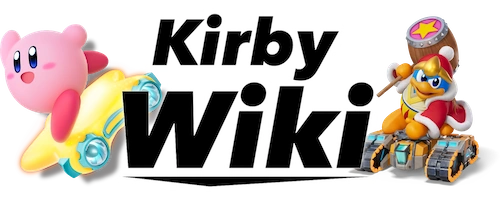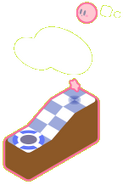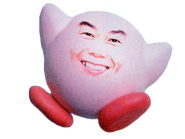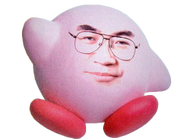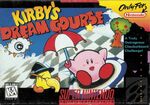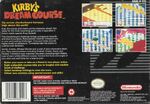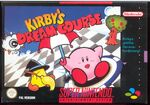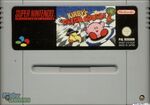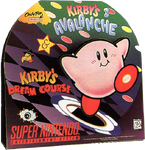(Undo revision 248625 by Borbot (talk) Due to this not being an official game, we don't talk about this here.) Tag: sourceedit |
No edit summary |
||
| (45 intermediate revisions by 9 users not shown) | |||
| Line 1: | Line 1: | ||
{{Infobox |
{{Infobox |
||
| − | | title = Kirby's Dream Course |
+ | | title = ''Kirby's Dream Course'' |
| − | | jap_title = カービィボウル |
+ | | jap_title = カービィボウル (Kābī Bōru) |
| − | | translation = |
+ | | translation = Kirby Bowl <br>カービィ = Kirby, ボウル = Bowl |
| us_boxart = [[File:KDC Boxart.jpg|270px]] |
| us_boxart = [[File:KDC Boxart.jpg|270px]] |
||
| pal_boxart = [[File:KDC Boxart P.jpg|270px]] |
| pal_boxart = [[File:KDC Boxart P.jpg|270px]] |
||
| jap_boxart = [[File:KDC Boxart J.jpg|200px]] |
| jap_boxart = [[File:KDC Boxart J.jpg|200px]] |
||
| − | | us_logo = [[File:KDC |
+ | | us_logo = [[File:KDC Logo Remaster.png|270px]] |
| jap_logo = [[File:KDC Logo J.png|270px]] |
| jap_logo = [[File:KDC Logo J.png|270px]] |
||
| − | | developer = [[HAL Laboratory]] |
+ | | developer = [[HAL Laboratory]], [[Wikipedia:Nintendo Entertainment Analysis & Development|Nintendo EAD]] |
| publisher = [[Nintendo]] |
| publisher = [[Nintendo]] |
||
| released = SNES<ref>[http://uk.gamespot.com/snes/sports/kirbybowl/similar.html?mode=versions Gamespot]</ref><br/>{{JP|September 21, 1994}}<br/>{{NA|February 1, 1995}}<br/>{{PAL|August 24, 1995}}<br> |
| released = SNES<ref>[http://uk.gamespot.com/snes/sports/kirbybowl/similar.html?mode=versions Gamespot]</ref><br/>{{JP|September 21, 1994}}<br/>{{NA|February 1, 1995}}<br/>{{PAL|August 24, 1995}}<br> |
||
| − | | re-released = Wii Virtual Console<ref>[http://vc.nintendolife.com/games/snes/kirbys_dream_course Nintendolife.com]</ref><br>{{JP|April 24, 2007}}<br>{{PAL|June 29, 2007}}<br>{{NA|July 23, 2007}}<br>{{KOR|February 24, 2009}}<br>Wii U Virtual Console<br>{{JP|May 8, 2013}}<br>{{NA|May 23, 2013}}<br>{{PAL|May 23, 2013}}<br>New Nintendo 3DS Virtual Console<ref>[http://www.gamnesia.com/news/heres-the-complete-list-of-every-snes-game-coming-to-the-virtual-console-on Gamnesia]</ref><br>{{JP|June 7, 2016}}<br>{{NA|July 28, 2016}} |
+ | | re-released = Wii Virtual Console<ref>[http://vc.nintendolife.com/games/snes/kirbys_dream_course Nintendolife.com]</ref><br>{{JP|April 24, 2007}}<br>{{PAL|June 29, 2007}}<br>{{NA|July 23, 2007}}<br>{{KOR|February 24, 2009}}<br>Wii U Virtual Console<br>{{JP|May 8, 2013}}<br>{{NA|May 23, 2013}}<br>{{PAL|May 23, 2013}}<br>New Nintendo 3DS Virtual Console<ref>[http://www.gamnesia.com/news/heres-the-complete-list-of-every-snes-game-coming-to-the-virtual-console-on Gamnesia]</ref><br>{{JP|June 7, 2016}}<br>{{NA|July 28, 2016}}<br>Super NES Classic Edition<br>{{NA|September 29, 2017}}<br>{{PAL|September 29, 2017}}<br>Nintendo Switch Online<br>{{NA|September 5, 2019}}<br>{{PAL|September 5, 2019}}<br>{{JP|September 5, 2019}} |
| genre = Golf |
| genre = Golf |
||
| modes = Single player / Two player alternating |
| modes = Single player / Two player alternating |
||
| ratings = ESRB: K-A (Kids to Adults) resp. E (Everyone)<br>ELSPA: 3+<br>PEGI: 3 (Wii-VC)<br>USK: 0 (Wii-VC) |
| ratings = ESRB: K-A (Kids to Adults) resp. E (Everyone)<br>ELSPA: 3+<br>PEGI: 3 (Wii-VC)<br>USK: 0 (Wii-VC) |
||
| − | | platforms = SNES<br>Wii (Virtual Console)<br>Wii U (Virtual Console) |
+ | | platforms = SNES<br>Wii (Virtual Console)<br>Wii U (Virtual Console)<br>New Nintendo 3DS (Virtual Console)<br>Super NES Classic Edition<br>Nintendo Switch (online subscription) |
}} |
}} |
||
| ⚫ | {{Quote|This golf-inspired game pitted one to two players against eight outlandish courses. To complete a hole, players had to defeat every enemy on the field and drop ball-shaped Kirby into the cup. Fewer shots meant a higher score. On top of planning each shot's power and trajectory, players had to make smart use of Kirby's 10 Copy Abilities.|Summary|[[Kirby's Dream Collection Special Edition]]}} |
||
| + | '''''Kirby's Dream Course''''' is a golf-themed [[Kirby (series)|''Kirby'' game]] developed by [[HAL Laboratory]] and [[Wikipedia:Nintendo Entertainment Analysis & Development|Nintendo EAD]]<ref>https://www.mobygames.com/game/snes/kirbys-dream-course/credits</ref> and published by [[Nintendo]] for the Super Nintendo Entertainment System (SNES). It was released in Japan on September 21, 1994, in North America on February 1, 1995 and in Europe on August 24, 1995. |
||
| + | ''Kirby's Dream Course'' was re-released on the Wii, Wii U, and New Nintendo 3DS Virtual Consoles. Additionally, it is one of the 21 games packaged with the Super NES Classic Edition system. It was also included in the initial lineup of SNES games for the Nintendo Switch Online service. |
||
| ⚫ | {{Quote|This golf-inspired game pitted one to two players against eight outlandish courses. To complete a hole, players had to defeat every enemy on the field and drop ball-shaped Kirby into the cup. Fewer shots meant a higher score. On top of planning each shot's power and trajectory, players had to make smart use of Kirby's 10 Copy Abilities.|Summary| |
||
| − | |||
| − | '''''Kirby's Dream Course''''', known in Japan as カービィボウル (''Kābī Bōru'', meaning '''''Kirby Bowl'''''), is a golf [[Kirby (series)|''Kirby'' game]] for the Super Nintendo Entertainment System (SNES) that was originally released in Japan on September 21, 1994, and was then later released on February 1, 1995 in North America and on August 24, 1995 in Europe. |
||
| − | |||
| − | This game is notable for being the very first 3D ''Kirby'' game. It is a golf style game with power ups. There are eight courses in the game and each one has eight holes. The game has a scoring system which awards Gold, Silver and Bronze medals for each level. There are unlockables in the game once a player gets enough medals. The player eventually meets a [[Mecha Dedede|robotic version]] of [[King Dedede]] at the top. |
||
==Story== |
==Story== |
||
| Line 37: | Line 35: | ||
==Gameplay== |
==Gameplay== |
||
| + | Although the graphics are entirely 2D, ''Kirby's Dream Course'' is notable for being the very first ''Kirby'' game with 3D gameplay and physics. It is a golf-style game with [[Copy Ability|Copy Abilities]] and [[enemy|enemies]] on each course. As suggested by its Japanese title, the game can also be said to contain elements of bowling, with the enemies serving as "pins." |
||
| ⚫ | The player uses [[Kirby]] as a ball. Kirby must hit all of the |
||
| ⚫ | |||
| − | The levels can have hazards such as water, sand, spikes, and moving floor traps. Some levels have switches that, if passed over by Kirby, will toggle these hazards off or on. Additionally, there are boost tiles and warp tiles, which are usually bigger. |
||
| ⚫ | The player uses [[Kirby]] as a ball. Kirby must hit all of the enemies on the course, the last enemy becoming a hole which must then be sunk into. There is a health meter with vitality represented by Tomatoes; these are lost each time Kirby makes a shot or is damaged by things like spikes, [[Gordo]]s and [[Kracko|Kracko's]] lightning. They can be gained back by sinking the ball and defeating enemies. If the player runs out of Tomatoes, Kirby loses a life; after losing all lives, the player is sent to repeat the failed course from the beginning. Copy Abilities can be gained by hitting certain enemies that possess them. These abilities can be used to achieve the goal more effectively depending on the situation of the player. There is a video tutorial system in the game which explains 20 different techniques, including the use of each ability. |
||
| ⚫ | |||
| + | |||
| + | The controls for "putting" and "chipping" Kirby like a golf ball are versatile, yet fairly simplified and intuitive. The D-pad rotates the direction he faces. Pressing up readies a fly shot. By default Kirby will aim straight forward in the direction he is facing, however, holding the B button before taking a shot and pressing left or right will apply a horizontal spin to his shot by gradual increments, represented on a meter known as the Spin Panel. If the shot is a fly shot, top spin or back spin can also be applied to Kirby in a similar manner, except the marker will automatically bounce up and down on a vertical meter of the Spin Panel, and must be stopped with good timing. |
||
| + | |||
| + | For determining the strength of a shot, a simple two-press power meter is used. If the meter is stopped at exactly 100%, it will turn pink, and the shot will be especially powerful. A partial indication of the path that Kirby's shot will take is displayed as an animated line of floating dots, known as the Roll Guideline. The player can attempt to extend the Roll Guideline by pressing down on the directional pad, though it will sometimes not fully appear if the calculations involved in predicting the shot's physics are too much for the Super Nintendo hardware and game engine to handle. |
||
| + | |||
| + | Some more advanced techniques include Rolling (holding down the A button to extend the length of a grounded Roll shot), Bouncing (pressing the A button with the right timing when landing from a Fly shot or bouncing off a bumper), and water Bouncing (skipping Kirby across water like a stone with the proper speed and trajectory). |
||
| ⚫ | |||
| + | The levels can have hazards like sand bunkers, turntables that can spin Kirby off course, and Danger Zones (spike pits), as well as special enemies like [[Whispy Woods]], Kracko, and Gordo who do not need to be defeated. Some levels have switches that, if passed over by Kirby, will toggle certain environmental hazards off or on. |
||
| + | |||
| + | Other environmental elements will help Kirby greatly if used effectively, such as Dash and Kick Panels for gaining speed and changing direction, and Warps for covering great amounts of distance instantaneously. Trampolines can be useful for navigating over obstacles. However, these elements are likely to send Kirby flying out of bounds if not used with careful planning and strategy. Water hazards can also help or hinder Kirby, either slowing him down greatly (while preventing the use of Copy Abilities), or providing a convenient method of travel with a skillful fly shot or the [[Freeze]] ability. Bumpers, appearing as thin green lines that are stretched around the outer edges of courses, are an especially common feature. They will ricochet Kirby away from them when touched, and are often the only thing protecting him from falling out of bounds. Mastering the skill of performing trick shots with bumper ricochets, and knowing the special ways in which certain Copy Abilities react to bumpers, is invaluable for attaining low scores. |
||
| + | |||
| + | Each course has a different par total number of strokes for awarding bronze, silver and gold medals, which are represented as leaderboard records set by different ''Kirby'' enemies. There are special unlockables in the game once a player gets enough medals, including a [[Sound Test]], map select and Extra variants of each course for both the 1P and 2P modes. |
||
| + | |||
| + | The game features twelve courses with eight holes each, not counting the lone boss stage. Eight of these courses are only playable solo, and four of them are exclusive to the 2Play Game, a versus mode. In 1Play Game, the player eventually meets and battles a [[Robo Dedede (Kirby's Dream Course)|robotic version]] of [[King Dedede]] in a special course with no holes. |
||
| + | |||
| + | Each course has an Extra variation that is more challenging than its normal counterpart, with altered placements of enemies and objects, and stricter score requirements for earning medals. |
||
| + | |||
| + | ===Multiplayer=== |
||
| ⚫ | |||
| ⚫ | |||
| ⚫ | In 2Play Game, the second player uses [[Keeby]] as a ball. Both players can play on one of four different multiplayer-specific courses, each having a more difficult Extra variation that can be unlocked. The four courses are each represented with different main enemies: [[Whispy Woods]], [[Mr. Shine & Mr. Bright]], [[Kracko]], and [[Gordo]]. In this mode, the players are set against one another in a competition to see who can get more stars. These can be obtained by defeating enemies and passing through or sinking into the hole; players can also steal each others' stars by passing through them. Stars obtained by player one (Kirby) will be colored pink, while the stars obtained by player two (Keeby) will be colored yellow. The player who gets the most stars after clearing all levels of the respective course is the winner. An enemy drops one star, a hole grants two. |
||
| + | |||
| + | The [[Transformer]] enemy appears exclusively in this mode, and since the Copy Ability that it drops is random, the selection of abilities available at any given time is less restricted than in single-player. As a result of this, the multi-player maps are generally not designed with the use of specific abilities in mind, which could also be to ensure greater fairness between the players. |
||
| + | |||
| ⚫ | The health meter is not represented by tomatoes in this mode; instead, they are changed into pink and yellow colored bars, respective to each player. If a player runs out of health, their respective character will get dizzy and fall asleep dreaming of food, losing a turn; after the turn has passed, the character will wake up and automatically get their health replenished by 4 bars. Colliding with the other player will bounce them away and drain one of their health bars. |
||
| + | |||
| + | Although players cannot be permanently KOed in this mode, attacking the other player is a viable strategy to gain stars, especially to knock them into a pit or remove them from the vicinity of a hole. Copy Abilities gain a new utility in multi-player for their damage potential against an opponent. For instance, Needle can be used to create a harmful stationary obstacle anywhere on the map, which the other player must avoid during their turn. However, a player who successfully bumps into and damages a player that possesses a Copy Ability will steal that ability for themselves. If both players have Copy Abilities, bump damage will exchange them. |
||
| + | |||
| ⚫ | There is a switch that only appears on this game mode: the Day & Night Switch. When hit for the first time, [[Mr. Shine & Mr. Bright|Mr. Shine]] will appear onscreen and switch the level's background to nighttime while simultaneously switching the number of stars acquired by one player with the other. If the switch is hit for a second time, [[Mr. Shine & Mr. Bright|Mr. Bright]] will appear onscreen and can effectively revert all effects. This switch can only be hit three times, after which it turns gray and stops working. Being a highly desirable switch for the player with less stars, it usually is located in hard-to-reach and dangerous spots. |
||
| + | |||
| + | Notably, the courses accessible in the two-player mode are missing some of the special environmental elements present in the 1Play Game, such as warps and conveyor belts. They were likely omitted due to difficulties in handling the physics of collisions between two players using these gimmicks, and balance issues that would arise from them. |
||
| + | |||
| + | ==Characters== |
||
| + | ===Playable Characters=== |
||
| + | *[[Kirby]] |
||
| + | *[[Keeby]] |
||
| + | |||
| + | ===Allies=== |
||
| + | {{db|:Category:Database/KDC}}{{Prep|{{Database/KDC/Allies/Raw}}}} |
||
| + | |||
| + | ===[[Regular enemy|Enemies]]=== |
||
| + | {{db|:Category:Database/KDC}}{{Prep|{{Database/KDC/Enemies/Raw}}}} |
||
| + | |||
| + | ===[[Boss]]es=== |
||
| + | {{db|:Category:Database/KDC}}{{Prep|{{Database/KDC/Bosses/Raw}}}} |
||
| + | |||
| + | |||
| ⚫ | |||
| + | There are 10 Copy Abilities in ''Kirby's Dream Course''. |
||
<!--{{db|Template:Database/KDC/Copy Abilities/Raw}} |
<!--{{db|Template:Database/KDC/Copy Abilities/Raw}} |
||
{{Prep|{{Database/KDC/Copy Abilities/Raw}}|{{!}}}}--> |
{{Prep|{{Database/KDC/Copy Abilities/Raw}}|{{!}}}}--> |
||
{| class="wikitable" cellpadding="0" cellspacing="0" style="width: 500px; text-align: center;" |
{| class="wikitable" cellpadding="0" cellspacing="0" style="width: 500px; text-align: center;" |
||
| − | |[[File:KDC Burning Icon sprite.png|link=Burning]]<br />[[Burning]] |
+ | |width=20%|[[File:KDC Burning Icon sprite.png|link=Burning]]<br />[[Burning]] |
| − | |[[File:KDC Freeze Icon sprite.png|link=Freeze]]<br />[[Freeze]] |
+ | |width=20%|[[File:KDC Freeze Icon sprite.png|link=Freeze]]<br />[[Freeze]] |
| − | |[[File:KDC Hi-Jump Icon sprite.png|link=Hi-Jump]]<br />[[Hi-Jump]] |
+ | |width=20%|[[File:KDC Hi-Jump Icon sprite.png|link=Hi-Jump]]<br />[[Hi-Jump]] |
| − | |[[File:KDC Needle Icon sprite.png|link=Needle]]<br />[[Needle]] |
+ | |width=20%|[[File:KDC Needle Icon sprite.png|link=Needle]]<br />[[Needle]] |
| − | |[[File:KDC Parasol Icon sprite.png|link=Parasol]]<br />[[Parasol]] |
+ | |width=20%|[[File:KDC Parasol Icon sprite.png|link=Parasol]]<br />[[Parasol]] |
| + | |- |
||
|[[File:KDC Spark Icon sprite.png|link=Spark]]<br />[[Spark]] |
|[[File:KDC Spark Icon sprite.png|link=Spark]]<br />[[Spark]] |
||
|[[File:KDC Stone Icon sprite.png|link=Stone]]<br />[[Stone]] |
|[[File:KDC Stone Icon sprite.png|link=Stone]]<br />[[Stone]] |
||
| ⚫ | |||
|[[File:KDC Tornado Icon sprite.png|link=Tornado]]<br />[[Tornado]] |
|[[File:KDC Tornado Icon sprite.png|link=Tornado]]<br />[[Tornado]] |
||
| ⚫ | |||
|[[File:KDC Wheel Icon sprite.png|link=Wheel]]<br />[[Wheel]] |
|[[File:KDC Wheel Icon sprite.png|link=Wheel]]<br />[[Wheel]] |
||
|} |
|} |
||
| + | ==Levels (Courses)== |
||
| − | === Two-Player Mode === |
||
| + | {{construction|issection=1}} |
||
| ⚫ | |||
| + | *Course 1 |
||
| ⚫ | |||
| + | *Course 2 |
||
| ⚫ | In |
||
| + | *Course 3 |
||
| + | *Course 4 |
||
| + | *Course 5 |
||
| + | *Course 6 |
||
| + | *Course 7 |
||
| + | *Course 8 |
||
| + | ==''Special Tee Shot''== |
||
| ⚫ | The health meter is not represented by tomatoes in this mode; instead, they are changed into pink and yellow colored bars, respective to each player. If a player runs out of health, their respective character will get dizzy and fall asleep, losing a turn; after the turn has passed, the character will wake up and automatically get their health replenished by 4 bars. |
||
| + | {{main|Kirby's Dream Course/Special Tee Shot}}''Kirby's Dream Course'' was based on the gameplay and engine of ''Special Tee Shot'', an originally unreleased SNES game made by Nintendo EAD. Before its planned release, it was decided that the game would be redesigned into a spin-off of the ''Kirby'' series, and HAL Laboratory was entrusted with the project. (HAL Laboratory already had extensive experience with golf games through their long-running ''Hole in One'' series, which may have influenced Nintendo's selection of them.) ''Special Tee Shot'' would eventually be released in its original form via the Satellaview peripheral in Japan only.<ref>[[nintendo:Special_Tee_Shot|http://nintendo.wikia.com/wiki/Special_Tee_Shot]] </ref> |
||
| + | ==Piracy== |
||
| ⚫ | There is a switch that only appears on this game mode: the |
||
| + | ''Kirby's Dream Course'' is the first ''Kirby'' game to contain multi-level anti-piracy measures. In this case, should the game be detected as a copy (checking for an unusual amount of SRAM that would indicate the use of a cartridge copier), it will hang the game at a warning screen. It also hangs the game if a copy of the NTSC versions is played on a PAL console, stating that it is not compatible. |
||
| + | |||
| + | Should that be bypassed, it will cause game behavior to change and make the game itself harder. In 1Play Mode, Kirby cannot recover health from defeating enemies and does not earn a 1UP from getting a hole in one. If Kirby manages to complete a course, the game crashes and deletes all save data. If Kirby runs out of lives, the Continue option is barred, and selecting the Game End option deletes all save data. In two-player mode, recovering from sleep causes Kirby or Keeby to regain only one point of health rather than four.<ref>[https://www.youtube.com/watch?v=kozJlohwEl8 YouTube]</ref> These changes were likely designed to fool software pirates into thinking that they had bypassed the game's copy protection, while rendering any illegitimate copies they may have made nearly unplayable. |
||
==Music== |
==Music== |
||
{{Main|{{PAGENAME}}/Music}} |
{{Main|{{PAGENAME}}/Music}} |
||
| − | == |
+ | ==Reception== |
| + | {{construction|issection=1}} |
||
| − | ''Kirby's Dream Course'' is the first ''Kirby'' game to contain anti-piracy measures. In this case, should the game be detected as a copy, it will hang the game at a warning screen. It also hangs the game if a copy of the North American version is played on a PAL console, stating that it is not compatible. Should that be bypassed, it will cause game behavior to change and make the game itself harder. In single-player mode, Kirby cannot recover health from defeating enemies and does not earn a 1UP from getting a hole in one. If Kirby manages to complete a course, the game crashes and deletes all save data. If Kirby runs out of lives, the Continue option is barred, and selecting the Game End option deletes all save data. |
||
| + | ==Transcript== |
||
| − | In two-player mode, recovering from sleep causes Kirby or Keeby to regain only one point of health rather than four.<ref>[https://www.youtube.com/watch?v=kozJlohwEl8 YouTube]</ref> |
||
| + | {{Main|Kirby's Dream Course/Transcript}} |
||
| + | |||
| + | ==Staff== |
||
| + | {{Main|List of Kirby's Dream Course Staff}} |
||
| + | {{construction|issection=1}} |
||
==Trivia== |
==Trivia== |
||
| − | *This game contains many sound effects from ''[[w:c:earthbound:EarthBound|EarthBound/Mother 2]]'' as both games were being developed side by side. |
+ | *This game contains many sound effects from ''[[w:c:earthbound:EarthBound|EarthBound/Mother 2]]'' as both games were being developed side by side at HAL Laboratory. |
| − | * |
+ | *Remnants from ''Special Tee Shot'' can be found unused in the Japanese version of ''Kirby's Dream Course''.<ref>http://wiki.rustedlogic.net/Kirby%27s_Dream_Course#Special_Tee_Shot_Connection</ref> Though not normally accessible, they were removed for international releases. |
| + | *It is possible to rename a save file using a code. The player must go to the Member screen and highlight the desired file, then hold L, R, and A to enter the name change screen.<ref>[https://web.archive.org/web/20001201193700/http://www.nintendo.com:80/codes/index.html Code Bank]</ref> |
||
| − | *This was the first game in the [[Kirby series|''Kirby'' series]] to have any kind of rating. The ESRB rating scale didn't exist when the [[Kirby's Dream Land|first]] [[Kirby's Adventure|three]] [[Kirby's Pinball Land|games]] were released. |
+ | *This was the first game in the [[Kirby series|''Kirby'' series]] to have any kind of age rating. The ESRB rating scale didn't exist when the [[Kirby's Dream Land|first]] [[Kirby's Adventure|three]] [[Kirby's Pinball Land|games]] were released. |
| − | *This is the first game to feature [[Kirby's house]]. |
+ | *This is the first game to feature an in-game depiction of [[Kirby's house]], though only in the Japanese version. |
*In the [[Sound Test|Music Room]] in ''[[Kirby and the Rainbow Curse]]'', ''Kirby's Dream Course'' is represented by an image of a hole. |
*In the [[Sound Test|Music Room]] in ''[[Kirby and the Rainbow Curse]]'', ''Kirby's Dream Course'' is represented by an image of a hole. |
||
*When playing ''amiibo tap: Nintendo's Greatest Bits'', if the player taps an [[Kirby (series)#List of amiibo products|amiibo]] product to the Wii U GamePad, there is a chance that he/she will unlock a demo of ''Kirby's Dream Course''. |
*When playing ''amiibo tap: Nintendo's Greatest Bits'', if the player taps an [[Kirby (series)#List of amiibo products|amiibo]] product to the Wii U GamePad, there is a chance that he/she will unlock a demo of ''Kirby's Dream Course''. |
||
*In two-player mode, if a player falls off the course while in nighttime, a [[Flapper]] will pick up the player instead of a [[Bronto Burt]], as it normally happens. |
*In two-player mode, if a player falls off the course while in nighttime, a [[Flapper]] will pick up the player instead of a [[Bronto Burt]], as it normally happens. |
||
| + | *The Bronto Burt in this game appears to be a sprite edit of the yellow ball character from ''Special Tee Shot.'' |
||
*If the player falls off the stage, Kirby/Keeby will lose two health bars/tomatoes. |
*If the player falls off the stage, Kirby/Keeby will lose two health bars/tomatoes. |
||
*It's possible to fall in the hole in Two-Player Mode, but not get the two stars that appear above the hole; this can only happen when the other player is at the edge of the hole. |
*It's possible to fall in the hole in Two-Player Mode, but not get the two stars that appear above the hole; this can only happen when the other player is at the edge of the hole. |
||
*If a Kirby rolls on an edge with inclines descending on both sides, Kirby will eventually fall to the right instead of staying on the edge. |
*If a Kirby rolls on an edge with inclines descending on both sides, Kirby will eventually fall to the right instead of staying on the edge. |
||
| + | *The [https://www.youtube.com/watch?v=4TH2VkfZbSs commercial] for this game was only aired in Japan, and the advertisement was referencing [[wikipedia:Galileo Galilei|Galileo Galilei]], and his famous experiment on gravity. In this experiment, Galileo used two spheres of different weight and dropped them from [[wikipedia:Leaning Tower of Pisa|The Leaning Tower of Pisa]]. In the commercial however, instead of using two spheres, he used a sphere and Kirby. When Kirby was falling to the earth's surface, he pulled out a parasol, allowing him to slowly fall towards the ground. This event adds some humor to the commercial because according to the results of this experiment, both spheres hit the ground at the same time. |
||
| + | *The game has a very unique save system in 1Play Game where the player can draw a low-resolution, black-and-white picture with the D-pad to personalize their save file and represent themselves in the score rankings. A pencil and eraser tool are present, as well as a number of ''Kirby''-themed stamps that can be applied to the drawing, such as a [[Maxim Tomato]]. This drawing system was originally present in ''Special Tee Shot''. |
||
| + | *For a brief time during the development transition, ''Kirby's Dream Course'' was known as ''Kirby's Tee Shot.'' |
||
| + | *The removal of the story in the English release was likely done in order to put the game on a cartridge with less memory. The Japanese original is 1.5 MB in size, while the other releases are only 1 MB. |
||
==Artwork== |
==Artwork== |
||
| + | <gallery> |
||
| + | K25 Kirby's Dream Course artwork.png|''[[Kirby series anniversaries#25th Anniversary|Kirby 25th Anniversary]]'' website |
||
| + | Kirby-bowl-guide-cover.png|Logo from the Japanese strategy guide |
||
| + | Kirby-miyamoto-1.png|Kirby with the face of [[wikipedia:Shigeru Miyamoto|Shigeru Miyamoto]], from the Japanese strategy guide |
||
| + | Kirby-iwata-1.png|Kirby with the face of [[wikipedia:Satoru Iwata|Satoru Iwata]], from the Japanese strategy guide |
||
| + | </gallery> |
||
| + | |||
===Box Art=== |
===Box Art=== |
||
<gallery widths="150" captionalign="center" spacing="small"> |
<gallery widths="150" captionalign="center" spacing="small"> |
||
| Line 102: | Line 176: | ||
KDC Cartridge.jpg|{{NA}} Cartridge |
KDC Cartridge.jpg|{{NA}} Cartridge |
||
KDC PAL Cartridge.jpg|{{PAL}} Cartridge |
KDC PAL Cartridge.jpg|{{PAL}} Cartridge |
||
| + | KDC_Banner.png|{{NA}} ''Kirby's Dream Course'' / ''[[Kirby's Avalanche]]'' banner |
||
| + | KDC_Counter_Card.png|{{NA}} ''Kirby's Dream Course'' / ''Kirby's Avalanche'' counter card |
||
</gallery> |
</gallery> |
||
===Logo=== |
===Logo=== |
||
<gallery widths="150" captionalign="center" spacing="small"> |
<gallery widths="150" captionalign="center" spacing="small"> |
||
| − | KDC logo.png|Logo |
+ | KDC logo.png|{{NA}} Logo |
| − | KDC Logo J.png| |
+ | KDC Logo J.png|{{JP}} Logo |
</gallery> |
</gallery> |
||
| Line 114: | Line 190: | ||
==References== |
==References== |
||
| − | <references/> |
+ | <references /> |
| − | |||
{{KDC}} |
{{KDC}} |
||
{{Games}} |
{{Games}} |
||
| − | {{DISPLAYTITLE: '' |
+ | {{DISPLAYTITLE: ''Kirby’s Dream Course''}} |
[[de:Kirby's Dream Course]] |
[[de:Kirby's Dream Course]] |
||
| Line 125: | Line 200: | ||
[[it:Kirby's Dream Course]] |
[[it:Kirby's Dream Course]] |
||
[[ja:カービィボウル]] |
[[ja:カービィボウル]] |
||
| + | [[zh:卡比梦想都]] |
||
[[Category:Games]] |
[[Category:Games]] |
||
[[Category:1990s games]] |
[[Category:1990s games]] |
||
| + | [[Category:Kirby's Dream Course]] |
||
| + | [[Category:Miscellaneous spin-offs]] |
||
Revision as of 03:28, 16 May 2020
| “ | This golf-inspired game pitted one to two players against eight outlandish courses. To complete a hole, players had to defeat every enemy on the field and drop ball-shaped Kirby into the cup. Fewer shots meant a higher score. On top of planning each shot's power and trajectory, players had to make smart use of Kirby's 10 Copy Abilities.” |
| — Summary • Kirby's Dream Collection Special Edition |
Kirby's Dream Course is a golf-themed Kirby game developed by HAL Laboratory and Nintendo EAD[4] and published by Nintendo for the Super Nintendo Entertainment System (SNES). It was released in Japan on September 21, 1994, in North America on February 1, 1995 and in Europe on August 24, 1995.
Kirby's Dream Course was re-released on the Wii, Wii U, and New Nintendo 3DS Virtual Consoles. Additionally, it is one of the 21 games packaged with the Super NES Classic Edition system. It was also included in the initial lineup of SNES games for the Nintendo Switch Online service.
Story
The plot of Kirby's Dream Course varies depending on the version. In the Japanese version, a short cutscene establishes the story if the player waits on the title screen. This cutscene was removed altogether in the North American localization. Instead, the North American instruction manual describes roughly the same story but with more details and slightly different events. A number of elements were added to justify or explain why certain things occur in the game, such as enemies dropping stars when Kirby defeats them.
Instruction manual 
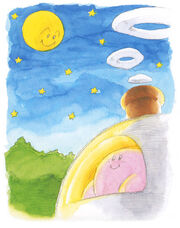
Kirby's Dream Course illustration
After the Fountain of Dreams was returned to normal, the inhabitants of Dream Land continue their peaceful lives. They grow attached to the beautiful stars in Planet Popstar's night sky. One night, they all look up into the sky to gaze at them. To their dismay, they discover that the thousands of stars have all vanished. Though some inhabitants try to remain optimistic, their hope fades over the following nights as the stars do not return.[5] Deeply saddened, their distress grows rapidly. Eventually they stop eating delicious meals, having pleasant dreams, laughing, and smiling.
In the midst of the turmoil, a rumor spreads that King Dedede is the one responsible for the stars' disappearance, having stolen them to keep their beauty all to himself. Kirby sets out to recover Dream Land's stars and teach Dedede a lesson. The hero heads to the king's floating castle, which is rigged with traps and secured by servants, each of which holds a missing star.[6]
=
After a lazy day, Kirby hopes to have a good dream in the starlight. He notices that all the stars in the sky are gone, save for one. All the following nights were the same way. Worried, Kirby takes a telescope and gaze into the night sky. As he does, he finds King Dedede floating by in the distance, pulling the last star behind him. Dedede realizes the pink puff is watching and speeds off, dropping the star. It lands on the ground near Kirby. The hero promptly jumps on the star and pursues the king at his floating castle.[7]
Gameplay
Although the graphics are entirely 2D, Kirby's Dream Course is notable for being the very first Kirby game with 3D gameplay and physics. It is a golf-style game with Copy Abilities and enemies on each course. As suggested by its Japanese title, the game can also be said to contain elements of bowling, with the enemies serving as "pins."
The player uses Kirby as a ball. Kirby must hit all of the enemies on the course, the last enemy becoming a hole which must then be sunk into. There is a health meter with vitality represented by Tomatoes; these are lost each time Kirby makes a shot or is damaged by things like spikes, Gordos and Kracko's lightning. They can be gained back by sinking the ball and defeating enemies. If the player runs out of Tomatoes, Kirby loses a life; after losing all lives, the player is sent to repeat the failed course from the beginning. Copy Abilities can be gained by hitting certain enemies that possess them. These abilities can be used to achieve the goal more effectively depending on the situation of the player. There is a video tutorial system in the game which explains 20 different techniques, including the use of each ability.
The controls for "putting" and "chipping" Kirby like a golf ball are versatile, yet fairly simplified and intuitive. The D-pad rotates the direction he faces. Pressing up readies a fly shot. By default Kirby will aim straight forward in the direction he is facing, however, holding the B button before taking a shot and pressing left or right will apply a horizontal spin to his shot by gradual increments, represented on a meter known as the Spin Panel. If the shot is a fly shot, top spin or back spin can also be applied to Kirby in a similar manner, except the marker will automatically bounce up and down on a vertical meter of the Spin Panel, and must be stopped with good timing.
For determining the strength of a shot, a simple two-press power meter is used. If the meter is stopped at exactly 100%, it will turn pink, and the shot will be especially powerful. A partial indication of the path that Kirby's shot will take is displayed as an animated line of floating dots, known as the Roll Guideline. The player can attempt to extend the Roll Guideline by pressing down on the directional pad, though it will sometimes not fully appear if the calculations involved in predicting the shot's physics are too much for the Super Nintendo hardware and game engine to handle.
Some more advanced techniques include Rolling (holding down the A button to extend the length of a grounded Roll shot), Bouncing (pressing the A button with the right timing when landing from a Fly shot or bouncing off a bumper), and water Bouncing (skipping Kirby across water like a stone with the proper speed and trajectory).
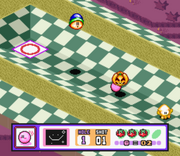
1Play Game
The levels can have hazards like sand bunkers, turntables that can spin Kirby off course, and Danger Zones (spike pits), as well as special enemies like Whispy Woods, Kracko, and Gordo who do not need to be defeated. Some levels have switches that, if passed over by Kirby, will toggle certain environmental hazards off or on.
Other environmental elements will help Kirby greatly if used effectively, such as Dash and Kick Panels for gaining speed and changing direction, and Warps for covering great amounts of distance instantaneously. Trampolines can be useful for navigating over obstacles. However, these elements are likely to send Kirby flying out of bounds if not used with careful planning and strategy. Water hazards can also help or hinder Kirby, either slowing him down greatly (while preventing the use of Copy Abilities), or providing a convenient method of travel with a skillful fly shot or the Freeze ability. Bumpers, appearing as thin green lines that are stretched around the outer edges of courses, are an especially common feature. They will ricochet Kirby away from them when touched, and are often the only thing protecting him from falling out of bounds. Mastering the skill of performing trick shots with bumper ricochets, and knowing the special ways in which certain Copy Abilities react to bumpers, is invaluable for attaining low scores.
Each course has a different par total number of strokes for awarding bronze, silver and gold medals, which are represented as leaderboard records set by different Kirby enemies. There are special unlockables in the game once a player gets enough medals, including a Sound Test, map select and Extra variants of each course for both the 1P and 2P modes.
The game features twelve courses with eight holes each, not counting the lone boss stage. Eight of these courses are only playable solo, and four of them are exclusive to the 2Play Game, a versus mode. In 1Play Game, the player eventually meets and battles a robotic version of King Dedede in a special course with no holes.
Each course has an Extra variation that is more challenging than its normal counterpart, with altered placements of enemies and objects, and stricter score requirements for earning medals.
Multiplayer
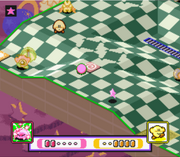
2Play Game
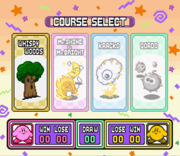
The Course Selection Screen in 2Play Game
In 2Play Game, the second player uses Keeby as a ball. Both players can play on one of four different multiplayer-specific courses, each having a more difficult Extra variation that can be unlocked. The four courses are each represented with different main enemies: Whispy Woods, Mr. Shine & Mr. Bright, Kracko, and Gordo. In this mode, the players are set against one another in a competition to see who can get more stars. These can be obtained by defeating enemies and passing through or sinking into the hole; players can also steal each others' stars by passing through them. Stars obtained by player one (Kirby) will be colored pink, while the stars obtained by player two (Keeby) will be colored yellow. The player who gets the most stars after clearing all levels of the respective course is the winner. An enemy drops one star, a hole grants two.
The Transformer enemy appears exclusively in this mode, and since the Copy Ability that it drops is random, the selection of abilities available at any given time is less restricted than in single-player. As a result of this, the multi-player maps are generally not designed with the use of specific abilities in mind, which could also be to ensure greater fairness between the players.
The health meter is not represented by tomatoes in this mode; instead, they are changed into pink and yellow colored bars, respective to each player. If a player runs out of health, their respective character will get dizzy and fall asleep dreaming of food, losing a turn; after the turn has passed, the character will wake up and automatically get their health replenished by 4 bars. Colliding with the other player will bounce them away and drain one of their health bars.
Although players cannot be permanently KOed in this mode, attacking the other player is a viable strategy to gain stars, especially to knock them into a pit or remove them from the vicinity of a hole. Copy Abilities gain a new utility in multi-player for their damage potential against an opponent. For instance, Needle can be used to create a harmful stationary obstacle anywhere on the map, which the other player must avoid during their turn. However, a player who successfully bumps into and damages a player that possesses a Copy Ability will steal that ability for themselves. If both players have Copy Abilities, bump damage will exchange them.
There is a switch that only appears on this game mode: the Day & Night Switch. When hit for the first time, Mr. Shine will appear onscreen and switch the level's background to nighttime while simultaneously switching the number of stars acquired by one player with the other. If the switch is hit for a second time, Mr. Bright will appear onscreen and can effectively revert all effects. This switch can only be hit three times, after which it turns gray and stops working. Being a highly desirable switch for the player with less stars, it usually is located in hard-to-reach and dangerous spots.
Notably, the courses accessible in the two-player mode are missing some of the special environmental elements present in the 1Play Game, such as warps and conveyor belts. They were likely omitted due to difficulties in handling the physics of collisions between two players using these gimmicks, and balance issues that would arise from them.
Characters
Playable Characters
Allies
| The following section contains transcluded content from the Database. Source: (view • edit • help) |
Bronto Burt • Flapper • Keeby • Mr. Shine & Mr. Bright
Enemies
| The following section contains transcluded content from the Database. Source: (view • edit • help) |
Broom Hatter • Chibi Dedede • Chilly • Flamer • Gaspar • Gordo • Kabu • Kracko • Mr. P. Umpkin • Rocky • Sparky • Squishy • Starman • Togezo • Transformer • Twister • UFO • Waddle Dee • Waddle Doo • Wheelie • Whispy Woods
Bosses
| The following section contains transcluded content from the Database. Source: (view • edit • help) |
Copy Abilities
There are 10 Copy Abilities in Kirby's Dream Course.
Burning |
Freeze |
Hi-Jump |
Needle |
Parasol |
Spark |
Stone |
Tornado |
UFO |
Wheel |
Levels (Courses)
| This section is currently under construction | |
- Course 1
- Course 2
- Course 3
- Course 4
- Course 5
- Course 6
- Course 7
- Course 8
Special Tee Shot
| Main article: Kirby's Dream Course/Special Tee Shot |
Kirby's Dream Course was based on the gameplay and engine of Special Tee Shot, an originally unreleased SNES game made by Nintendo EAD. Before its planned release, it was decided that the game would be redesigned into a spin-off of the Kirby series, and HAL Laboratory was entrusted with the project. (HAL Laboratory already had extensive experience with golf games through their long-running Hole in One series, which may have influenced Nintendo's selection of them.) Special Tee Shot would eventually be released in its original form via the Satellaview peripheral in Japan only.[8]
Piracy
Kirby's Dream Course is the first Kirby game to contain multi-level anti-piracy measures. In this case, should the game be detected as a copy (checking for an unusual amount of SRAM that would indicate the use of a cartridge copier), it will hang the game at a warning screen. It also hangs the game if a copy of the NTSC versions is played on a PAL console, stating that it is not compatible.
Should that be bypassed, it will cause game behavior to change and make the game itself harder. In 1Play Mode, Kirby cannot recover health from defeating enemies and does not earn a 1UP from getting a hole in one. If Kirby manages to complete a course, the game crashes and deletes all save data. If Kirby runs out of lives, the Continue option is barred, and selecting the Game End option deletes all save data. In two-player mode, recovering from sleep causes Kirby or Keeby to regain only one point of health rather than four.[9] These changes were likely designed to fool software pirates into thinking that they had bypassed the game's copy protection, while rendering any illegitimate copies they may have made nearly unplayable.
Music
| Main article: Kirby's Dream Course/Music |
Reception
| This section is currently under construction | |
Transcript
| Main article: Kirby's Dream Course/Transcript |
Staff
| Main article: List of Kirby's Dream Course Staff |
| This section is currently under construction | |
Trivia
- This game contains many sound effects from EarthBound/Mother 2 as both games were being developed side by side at HAL Laboratory.
- Remnants from Special Tee Shot can be found unused in the Japanese version of Kirby's Dream Course.[10] Though not normally accessible, they were removed for international releases.
- It is possible to rename a save file using a code. The player must go to the Member screen and highlight the desired file, then hold L, R, and A to enter the name change screen.[11]
- This was the first game in the Kirby series to have any kind of age rating. The ESRB rating scale didn't exist when the first three games were released.
- This is the first game to feature an in-game depiction of Kirby's house, though only in the Japanese version.
- In the Music Room in Kirby and the Rainbow Curse, Kirby's Dream Course is represented by an image of a hole.
- When playing amiibo tap: Nintendo's Greatest Bits, if the player taps an amiibo product to the Wii U GamePad, there is a chance that he/she will unlock a demo of Kirby's Dream Course.
- In two-player mode, if a player falls off the course while in nighttime, a Flapper will pick up the player instead of a Bronto Burt, as it normally happens.
- The Bronto Burt in this game appears to be a sprite edit of the yellow ball character from Special Tee Shot.
- If the player falls off the stage, Kirby/Keeby will lose two health bars/tomatoes.
- It's possible to fall in the hole in Two-Player Mode, but not get the two stars that appear above the hole; this can only happen when the other player is at the edge of the hole.
- If a Kirby rolls on an edge with inclines descending on both sides, Kirby will eventually fall to the right instead of staying on the edge.
- The commercial for this game was only aired in Japan, and the advertisement was referencing Galileo Galilei, and his famous experiment on gravity. In this experiment, Galileo used two spheres of different weight and dropped them from The Leaning Tower of Pisa. In the commercial however, instead of using two spheres, he used a sphere and Kirby. When Kirby was falling to the earth's surface, he pulled out a parasol, allowing him to slowly fall towards the ground. This event adds some humor to the commercial because according to the results of this experiment, both spheres hit the ground at the same time.
- The game has a very unique save system in 1Play Game where the player can draw a low-resolution, black-and-white picture with the D-pad to personalize their save file and represent themselves in the score rankings. A pencil and eraser tool are present, as well as a number of Kirby-themed stamps that can be applied to the drawing, such as a Maxim Tomato. This drawing system was originally present in Special Tee Shot.
- For a brief time during the development transition, Kirby's Dream Course was known as Kirby's Tee Shot.
- The removal of the story in the English release was likely done in order to put the game on a cartridge with less memory. The Japanese original is 1.5 MB in size, while the other releases are only 1 MB.
Artwork
Box Art
Media
Logo
External links
References
- ↑ Gamespot
- ↑ Nintendolife.com
- ↑ Gamnesia
- ↑ https://www.mobygames.com/game/snes/kirbys-dream-course/credits
- ↑ Kirby's Dream Course instruction manual (p. 2 and 3)
- ↑ Kirby's Dream Course instruction manual (p. 4 and 5)
- ↑ Intro cutscene
- ↑ http://nintendo.wikia.com/wiki/Special_Tee_Shot
- ↑ YouTube
- ↑ http://wiki.rustedlogic.net/Kirby%27s_Dream_Course#Special_Tee_Shot_Connection
- ↑ Code Bank
